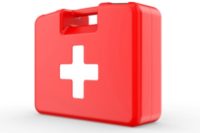- Make a quick assessment of the situation. This is when training and experience play a vital role in addressing the situation.
- Make the victim sit comfortably with the head tilted to the side of the injured eye. Check the seriousness of the injury. If possible, carefully open the eye and ask the victim to move their eye around. Gently examine the surface over and under the eyelids.
- The eyes move as one unit. As one eye moves, so does the other. It is not possible to immobilize just one eye. This is critical to know especially if there are foreign objects inside the eye.
- For chemical contamination, never proceed without a pair of medical gloves. It is protocol to have a safety guideline for industries engaged in handling chemicals.
- A safety data sheet (SDS) should always be available to reference the chemical and its appropriate handling and treatment.
- In case of eye contamination, it is ideal to irrigate the eye with water for 20 minutes. If only one eye is affected, make sure to cover the unaffected eye with a sterile dressing before flushing. Make all the necessary means to make sure the other eye in unaffected.
- Inspect eyewash packages prior to applying them to the eye. It is imperative to regularly check the expiration date of this supply.
- Injury to the eye sockets are likely caused by a severe trauma to the head or neck. So if there is indeed an injury to those parts, it's best to prioritize them. Swelling can be immediately relieved by a cold compress.
- Examine the severity of the injury. If there is bleeding in the eye, gently dress it to control the bleeding.
- Do not apply pressure as it may worsen the injury. The best course of action is immediate medical attention.
- Overexposure to UV rays, like in welding, can result in the inflammation of the cornea. Significant exposure is felt several hours later. It is like having sand in your eyes.
- A few drops of dilating drops can help relax the eye muscles and alleviate the pain. Keep the victim in a dark room and immediately pad the eyes. It is best to rush the victim to the nearest hospital.
- When foreign objects enter the eye, carefully examine the eye and assess the size of the object. If the object inside the eye is too big, do not attempt to take it out.
- Lay the victim down and immediately call for an ambulance. For minor objects, flushing the eye as mentioned above is the best treatment.
- If there is a need for professional medical attention, as with any other emergency, never leave the victim alone.
- If there are other people in the vicinity, have someone contact an ambulance and meet the incoming help.
- Always be ready with important details like your exact location and a concise description of the incident.
- Having a guide on how to conduct first aid for eye injury can help save lives.
Preserve your sight: 18 first aid tips to treat injuries


